GET INFORMED about the Characteristics of Different Models of EMG Active Pickups for Electric Guitar.
Active Pickups For Electric Guitars Explained
While Humbucker pickups were designed to improve sustain and eliminate the hum of single-coil pickups, active pickups were developed to take sustain and interference elimination one step further.
Passive pickups have a high impedance output, so they can be prone to picking up interference.
In the case of high-gain passive pickups with larger magnets to generate greater output, the power of these magnets can exert a force on the strings, influencing their free vibration and consequently affecting the sustain of the instrument.
The design of active pickups is based on a pickup that emits a low-impedance signal, processed through a preamplifier integrated into the circuit.
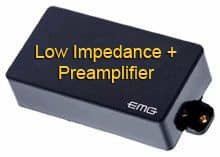
This 9 volt battery powered preamplifier boosts the output signal to a level that is less affected by electromagnetic interference. Furthermore, the resulting signal has the advantage of not degrading when transmitted over long cables.
Therefore, an active pickup produces a stronger output than a passive pickup, using less powerful magnets that can interfere with the vibrations of the strings, and significantly increases the sustain of the instrument.
This achieves an unbeatable signal-to-noise ratio, as well as a signal that does not degrade, regardless of how many meters of cable there are between your guitar and the amplifier.
Pots for Active Pickups
This preamp also allows for more powerful and precise tone control than the standard passive circuits found in most guitars.
However, replacing passive pickups with a set of active pickups involves some difficulties.
To begin with, the wiring and potentiometers of a passive circuit would not work for an active circuit, since the 25 kiloohms potentiometer is the standard for active pickups, while passive pickups normally require 250 or 500 kiloohms potentiometers.
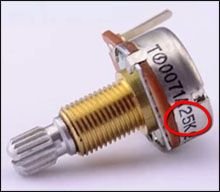
In addition, we will need enough space in the cavity of the potentiometers, to accommodate the battery that powers the preamplifier.
If to access the cavity we must remove the strings and the pickguard as in the Stratocaster models, it would not hurt to place a long-lasting battery. Since removing the strings and pickguard to change the battery is not something we want to do often. In any case, a good 9-volt battery rarely lasts less than 10 or 12 months.
Always Disconnect the Guitar Jack
It also doesn’t hurt to always remember to disconnect the plug from the guitar when we finish playing, because this will consume the battery, significantly reducing the useful life of the battery.
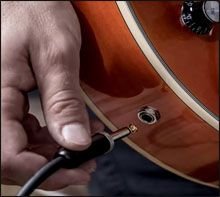
Due to all these particularities, their different output levels and other electrical properties, it is generally not possible to combine active and passive pickups in the same instrument.
The active pickups capture the vibration of the string so faithfully and clearly that they barely detect the vibrations coming from the wood of the guitar. For this reason, the resulting sound in guitars with different woods is hardly perceptible when it comes to active pickups.
Precisely the precision of this type of pickups, can be “cold” or unnatural, as is the case with precise Digital Delays pedals in comparison with the Analog Delays. But in reality, they are simply different effects, and in the case of active or passive pickups, one is not better than the other, they are simply different, and each type of pickup has its own qualities and different characteristics.
Due to their high performance, active pickups are highly valued in genres such as hard rock and heavy metal, although they are also used in other musical genres.
Active pickups are ideal for high-gain sounds without the resulting noise problems, and are very useful in studio recordings and on stages with extensive lighting that could cause interference, as in the case of David Gilmour and his spectacular live lighting.

EMG Active Pickups: Different Types
The first to develop active pickup technology was the American brand EMG.
Although many brands currently sell active pickups, EMG remains the market leader in this type of pickup. Used by many guitar brands such as ESP, Epiphone, Dean, Jackson, BC Rich, Godin, Ibanez, Schecter, Cort, and even Fender and Gibson.
As with most pickups, EMG active pickups are available in different finishes to suit the aesthetics of the guitar in question, or our personal taste.
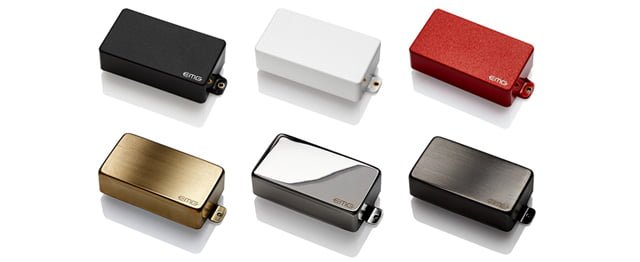
EMG Humbucker
EMG 81
The first model marketed by the Californian brand was the popular EMG 81. A high-performance dual pickup, to the delight of the most forceful musicians. This model features a ceramic magnet and is characterised by its great sustain and high output level.
The EMG 81 is commonly found in the bridge position, but some guitarists, such as Kirk Hammett, also use it in the neck position. One of the highest output active pickup sets we can install on our guitar.
EMG 85
For greater versatility and a more organic and docile sound, we have the EMG 85 made with alnico V magnet. With this pickup we can play from Blues to Metal, and it would be the equivalent of a powerful classic Humbucker in active format. Its most common placement would be in the neck position, but its performance in the bridge position would be equally optimal.
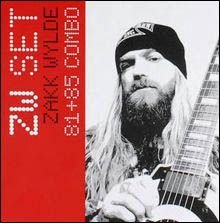
If we need more reinforcement for the bridge position, we can install an EMG 81 in that position. One of EMG’s best-known pickups sets, made popular by guitarist Zakk Wylde. Although the musician has his own signature set of pickups on the market (EMG Zakk Wylde).
EMG 60
On the other hand, in the neck position we can also consider the EMG 60 with ceramic magnet. In this way we will obtain the great sustain and output typical of good active pickups, but probably with the best clean sound of the entire brand.
For a warmer sound, we have the EMG 60A with alnico V magnet. This model would also be optimal for bridge position, with a more classic and controllable sound.
EMG Single Coil
In a single coil pickup format, we have the EMG S with a ceramic magnet for a high-output Stratocaster sound.
And the EMG SA with alnico V magnets for a more balanced output and vintage Stratocaster-style tone. Used by David Gilmour on his Red Strat (EMG DG20 David Gilmour Set).
For a classic HSS pickup configuration, we can opt for an EMG 85 in bridge position, along with two EMG SA. This is the setup Mark Knopfler uses on his Pensa Shure MK 1.
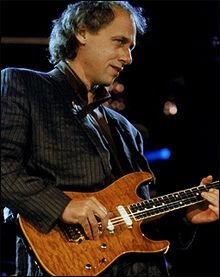
On the other hand, if we need a configuration with even more punch, we can opt for an EMG 81 in bridge position, along with two EMG S such as the EMG KH20 Kirk Hammett set.
EMG Pickups for Telecaster
For classic Telecaster style sounds we have the EMG RT and the EMG FT with alnico magnet. And for more aggressive tones we have the EMG RTC and the EMG FTC with ceramic magnet.
EMG also has humbucking models in a P90-style housing (EMG P60) and in a mini-humbucker format (EMG M50).
Swap EMG Pickups
Swapping different models of EMG pickups is a breeze. Since its installation without welding allows you to simply disconnect the installed one, and connect the new one.
Unless they are coil split system like the EMG 89. This model integrates the sound of an 85 and an SA in the same pickup.

Seymour Duncan Active Pickups
Seymour Duncan is a mythical brand of passive pickups, but also sells high quality active pickups. Consequently, it forces the EMG brand to introduce improvements to its most legendary pickups so as not to be left behind, such as the X series.
This series takes its name from its new X preamp, which offers greater dynamic and organic response, to bring the active sound ever closer to the qualities of the passive sound.
